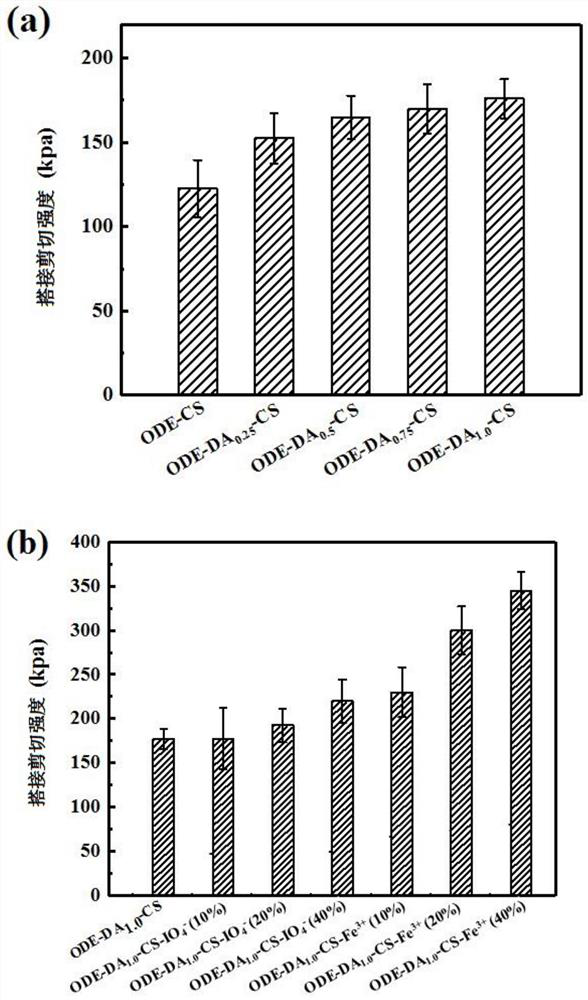Injectable biological adhesive, preparation method and application thereof
A technology of biological adhesive and oxidative cross-linking agent, applied in the field of polymer materials and biological materials, to achieve the effect of broad application prospects, no cytotoxicity, and excellent tissue adhesion performance
- Summary
- Abstract
- Description
- Claims
- Application Information
AI Technical Summary
Problems solved by technology
Method used
Image
Examples
preparation example Construction
[0037] The preparation method of the oxidized dextran involved in the following examples is as follows:
[0038] Weigh 4g dextran (DE, M w =2×10 3 ) was dissolved in 80mL deionized water, and 0.244g of sodium periodate (NaIO 4 ), after reacting at room temperature in the dark for 12 hours, ethylene glycol was added to terminate the reaction and dialyzed in deionized water to remove unreacted small molecules until there was no iodate in the dialysate. First take 1mL of dialysate and add 1mL of 1wt% AgNO to it 3 Solution, and there is no precipitation, which proves that the unreacted periodate has been completely removed, and then the liquid in the dialysis bag is freeze-dried to obtain a white powder modified macromolecular ODE 5 , and their degree of oxidation was 5.1%, respectively.
[0039] It should be noted that when NaIO 4 The amount of oxidized dextran prepared by 0.488, 0.976, 1.464, 1.952 is recorded as ODE 10 , ODE 20 , ODE 30 , ODE 40 , the degree of oxidation...
Embodiment 1
[0042] Oxidized dextran-dopamine-chitosan-sodium periodate (ODE-DA-CS-IO 4 - ) preparation of double cross-linking binder:
[0043] Take 190μL 10wt% CS aqueous solution, and add 17.77mg dopamine to it, shake and mix to form a mixed solution; then take 1mL 10wt% ODE 40 PBS solution, and to which was added 2.48mg of NaIO 4 , mix well to form a mixed solution; mix the two mixed solutions (wherein, ODE 40 Aldehyde group in CS, amino group in CS, amino group in DA and NaIO 4 The ratio is 2:1:1:0.1), observe the time of gel formation, and the obtained hydrogel is recorded as ODE-DA-CS-IO 4 - (10mol%) hydrogel binder.
[0044] It should be noted that when taking NaIO 4 The mass of 4.96mg and 9.92mg of the prepared hydrogel is recorded as ODE-DA-CS-IO 4 - (20mol%), ODE-DA-CS-IO 4 - (40mol%) hydrogel binder.
[0045] The schematic diagram of its preparation is as figure 1 (c) shown.
Embodiment 2
[0047] Oxidized dextran-dopamine-chitosan-iron (ODE-DA-CS-Fe 3+ ) preparation of double cross-linking binder:
[0048] Take 190μL of 10wt% CS solution, and add 17.77mg of dopamine to it, shake and mix to form a mixed solution; then take 1mL of 10wt% ODE 40 PBS solution, to which 1.88mg FeCl was added 3 , mix well to form a mixed solution; mix the two mixed solutions (wherein, ODE 40 Aldehyde group in CS, amino group in CS, amino group in DA and FeCl 3 The molar ratio is 2:1:1:0.1), observe the time of gel formation, and the obtained hydrogel is recorded as ODE-DA-CS-Fe 3+ (10mol%) hydrogel binder.
[0049] It should be noted that when the amount of cross-linking agent ferric chloride was 3.76mg and 3.56mg respectively, the prepared bioadhesive materials were recorded as ODE-DA-CS-Fe 3+ (20mol%) and ODE-DA-CS-Fe 3+ (40mol%).
[0050] The schematic diagram of its preparation is as figure 1 (d) shown.
PUM
 Login to View More
Login to View More Abstract
Description
Claims
Application Information
 Login to View More
Login to View More - R&D
- Intellectual Property
- Life Sciences
- Materials
- Tech Scout
- Unparalleled Data Quality
- Higher Quality Content
- 60% Fewer Hallucinations
Browse by: Latest US Patents, China's latest patents, Technical Efficacy Thesaurus, Application Domain, Technology Topic, Popular Technical Reports.
© 2025 PatSnap. All rights reserved.Legal|Privacy policy|Modern Slavery Act Transparency Statement|Sitemap|About US| Contact US: help@patsnap.com



